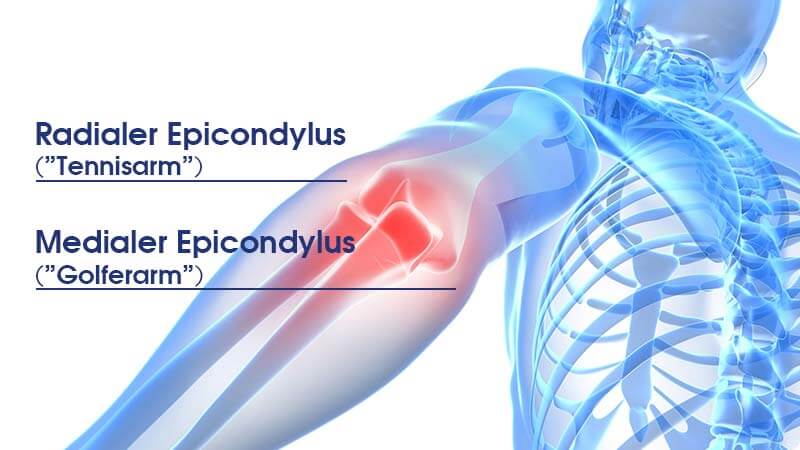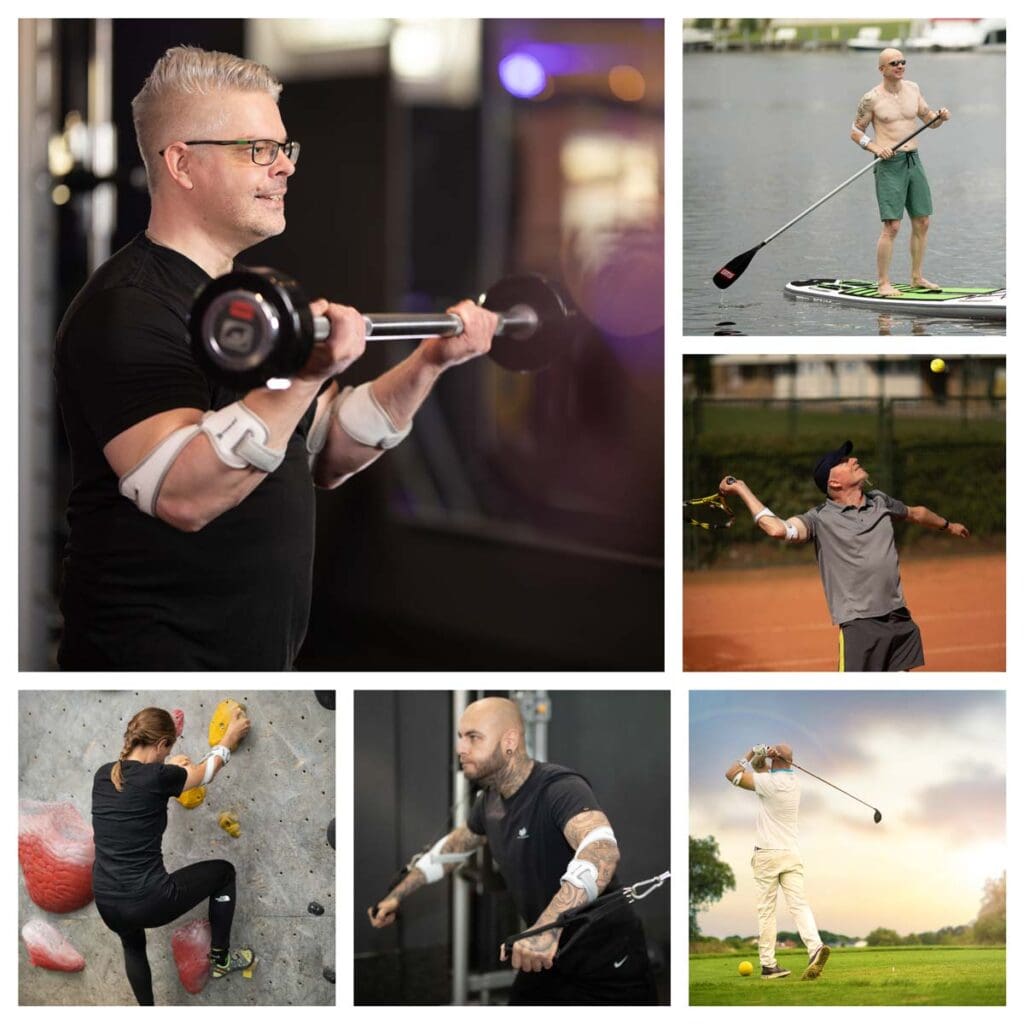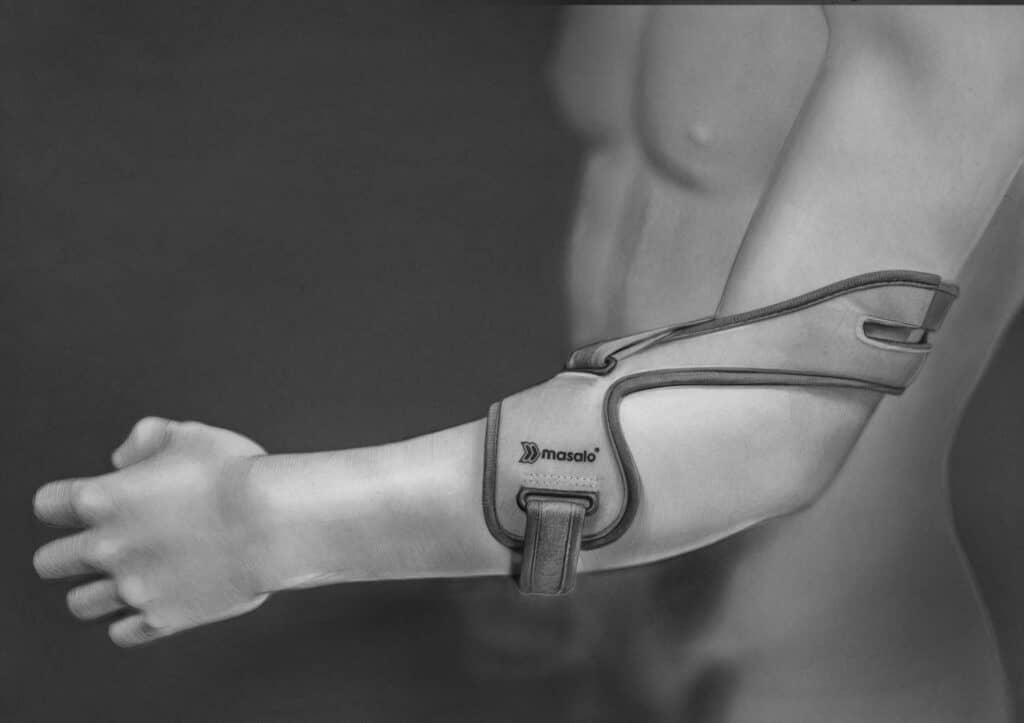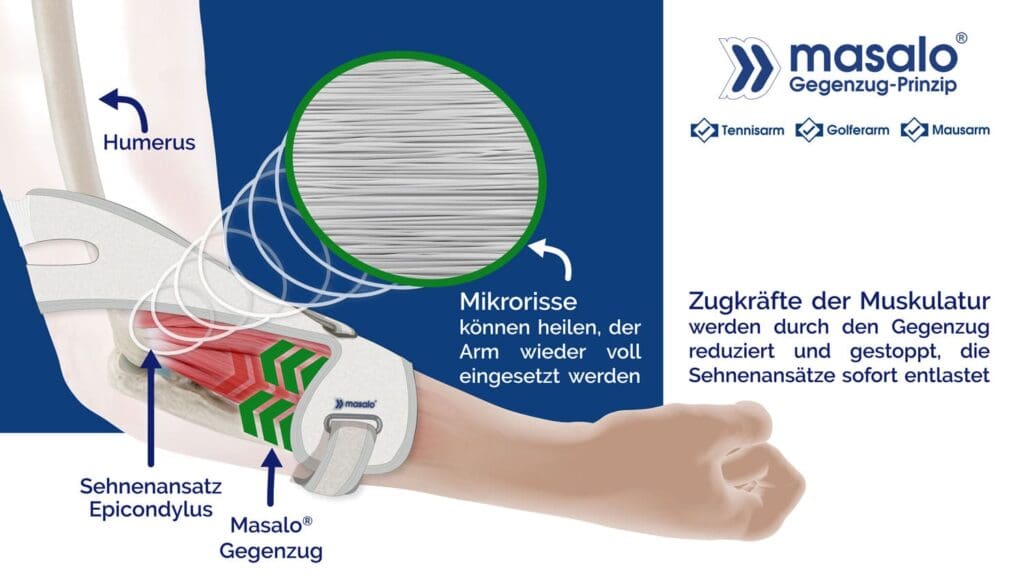Sport despite tennis elbow
Epicondylitis - development and information
The epicondylitisEpicondylitis, better known as tennis elbow or golfer's elbow, is widespread in all areas of sport, especially in power sports and sports with additional arm or hand strain (weights, sticks, clubs, etc.).
This injury to the tendon insertions of the forearm is caused by tensile forces that act on the arm every time it moves. Overloading can lead to micro-tears, which can then become inflamed and cause severe pain.
Repetitive strain and repetitive movements then exacerbate the injury and the pain in the elbow area.
The repetitive exercises deliberately performed during strength training, for example - i.e. several repetitions, several sets - and the minor overloads (muscle soreness) that are also often deliberately accepted, lead to the widespread use of tennis and golfer's elbow in strength training and fitness.
Particularly in bodybuilding or weightlifting, the strain is of course especially great, as the high weights exert enormous forces on the muscles and tendons.
The term tennis elbow or golfer's elbow depends on which muscle area and which tendon insertion is affected.
The common term for the outer tendon, the radial epicondyle, is tennis elbow, while the inner tendon, the medial epicondyle, is referred to as golfer's elbow or golfer's elbow. Due to the widespread prevalence of the injury in both sports, these terms have become the colloquial term for epicondylopathy.

Diagram: Tennis elbow and golfer's elbow
Tamer Galal, Mr. Universe 2004, was only able to overcome his tennis elbow with the Masalo® sleeve.
Tennis elbow in weight training & bodybuilding
Epicondylitis is often triggered by bicep curls or similar exercises when it occurs on the outside of the forearm. Especially when performing the exercise with a straight barbell, the angle is relatively unfavorable for the tendons and the tensile forces are particularly strong, which can promote the development of the injury.
However, tennis elbow is not always caused by sport. Even simple work at home, at work or at the PC can trigger epicondylitis, which is often exacerbated by strength training.
The pain is often particularly severe when loading the biceps, exercises such as bench presses, chest presses, etc. - generally exercises in which the main load occurs during the extension phase of the arm or where the arm has to be held against high weights.
Golfer's arm in weight training & bodybuilding
If the injury occurs on the inside of the forearm, this is known as golfer's elbow.
This is mainly caused by exercises that put a lot of strain on the inside or exert a strong pull, such as tricep exercises with inclined handles on the pull-up tower, lat pull-ups, pull-ups or butterfly.
Here too, however, there is no standard trigger for the injury; there can be many different reasons for the development of epicondylitis.
Diagnosis:
If you have pain in the elbow area or elbow joint, please only have a diagnosis made by a medical professional. The information on our website cannot replace this.
If you have been diagnosed with tennis elbow or golfer's elbow, we would like to introduce you to our product, which can also help you regain freedom from pain and unhindered enjoyment of sport, regardless of whether you are a bodybuilder or weightlifter, or whether strength training in the gym or at home is simply part of your well-being.
Exercising with a Masalo cuff
Whether it's tennis elbow or golfer's elbow, if the tensile forces of the forearm muscles and tendons cause the injury and make it worse with every movement, isn't it best to relieve the affected area with a countertraction?
As soon as the tensile forces of the forearm muscles are absorbed or redirected by a counter-traction system, shouldn't this clearly support the healing process and alleviate or eliminate the pain?
This is exactly what the Masalo® cuff does. The counter-traction system provides immediate and lasting relief to the affected area. The tendons are protected, pain is relieved and healing is positively supported - even though the arm continues to be used. The unique design of the Masalo® cuff means it can be worn 24 hours a day, day and night.

When playing tennis, the experiences of other customers have shown that the racket position is improved. The stabilization of the elbow leads to greater hitting power. Those affected have also benefited from the cuff in other sports such as javelin throwing, handball and volleyball.
In golf, the Masalo® cuff acts as a guide for the golf swing and can therefore improve your handicap.
Strength training can also usually be resumed quickly without long downtimes. The cuff also provides constant performance and drastically reduces the susceptibility of the tendons to injury despite the high loads, particularly when preparing for competitions for bodybuilders and competitive athletes.
In addition, a wrist support can help to stabilize the wrists and prevent hyperextension of the wrists.
Extreme sports with Masalo cuff
Dr. Garvin Aussenegg proves with this impressive video that even extreme sports such as mountaineering etc. are possible again without any problems with the Masalo® sleeve. Without the cuffs, the pain from his golfer's arms was unbearable. After putting on the supports, however, he immediately went to the summit!
Enjoy the beauty of nature in fantastic pictures!
You are welcome to support the YouTube channel of Dr. Garvin Aussenegg
How does the Masalo cuff work?
The Masalo® Cuff MED works with the proven Masalo® countertraction principle, which is still unique in the field of epicondylitis aids.
Over 70,000 customers have already been able to overcome their injury with the help of our Masalo® cuff and return to their sport with renewed vigor.
The arm remains fully mobile even with the cuff.

How does the Masalo cuff work?
The comfortable forearm cuff of the Masalo® Cuff MED is placed approximately in the middle of the forearm and fixed with the high-quality and very durable Velcro fastener.
The upper arm strap is then also fastened with a Velcro fastener and adjusted according to the activity and load.
Thanks to the unique and patented design, the upper arm strap stays in place with every movement. Slipping of the belt is prevented by an additional element with silicone studs on the inside (this can also be easily removed as an option). The tensile forces are reduced or completely stopped by the proven counter-tension principle, relieving the affected area. The negative tensile forces are redirected to the upper arm strap.
This gives the affected tendons a chance to heal, although the arm can still be used and loaded.
Further details on the function and operating principle can be found here:
Common treatment methods and alternative therapy for epicondylitis
Prolonged immobilization of the arm is usually not an option for ambitious bodybuilders, fitness enthusiasts or weightlifters, as their lives are too strongly tailored to sport.
In addition, immobilization can ultimately also lead to the tendons losing elasticity due to the lack of strain and the injury then recurring all the more quickly after a later resumption of training.
"Normal" tennis supports, orthoses or braces always work with pressure (compression) on the muscle bellies and therefore use a completely different approach.
The Masalo® cuff does not work with compression, but with the unique countertraction principle and can therefore be worn permanently.
The healing process can be positively supported by the ensured blood circulation, and the arm is supported and relieved even at night.

Diagram: Operating principle of the Masalo® Cuff MED
Tips for strength training
If you want to use our Masalo® cuff and have decided to keep it, we recommend the following to ensure a quick resumption of training and a speedy recovery:
- If your cuff fits well, you can feel the countertraction/relief and you can go about your everyday life normally again, there is nothing to stop you from resuming training. However, we recommend that you refrain from stretching your arm completely at first and start your training with light weights and exercises.
- In the gym, for example, use less weight and do more repetitions.
- Do not work with momentum during training, but perform the repetitions extremely slowly and cleanly, taking 4-5 seconds per movement. This results in intensive training and maximum strain on the muscles, but only minimal strain on the injured tendon insertions.
- Once you have conquered your epicondylitis, continue to train with the Masalo® sleeve to prevent possible relapses and continue to relieve the affected area. Many of our sports customers often even use a second cuff for their training and wear it well beyond the actual injury period.
- When you are fully recovered, use the usual stretching exercises for the body and arm. This can increase the elasticity of the tendons and reduce the possibility of a recurrence of the injury.
- However, DO NOT stretch your arm if you are still in acute pain. As this represents a renewed overloading and overstimulation of the tendon insertions, it may even make the pain and the injury significantly worse.
- If necessary, use an additional wrist support to stabilize the wrists
Nutrition and dietary supplements
A healthy diet and nutritional supplements can also help to strengthen the tendons, muscles and joints, which reduces the risk of a subsequent recurrence of injury.
Together with the Masalo® cuff, epicondylitis can therefore be effectively combated and also prevented.
But be sure to seek professional advice on this!
Summarized tips for epicondylitis:
-
Correctly applied Masalo cuff
-
Clean training (personal training)
-
Adjusted weights
-
Load control
-
Healthy diet
-
Useful food supplement
